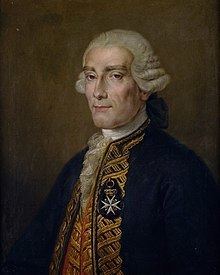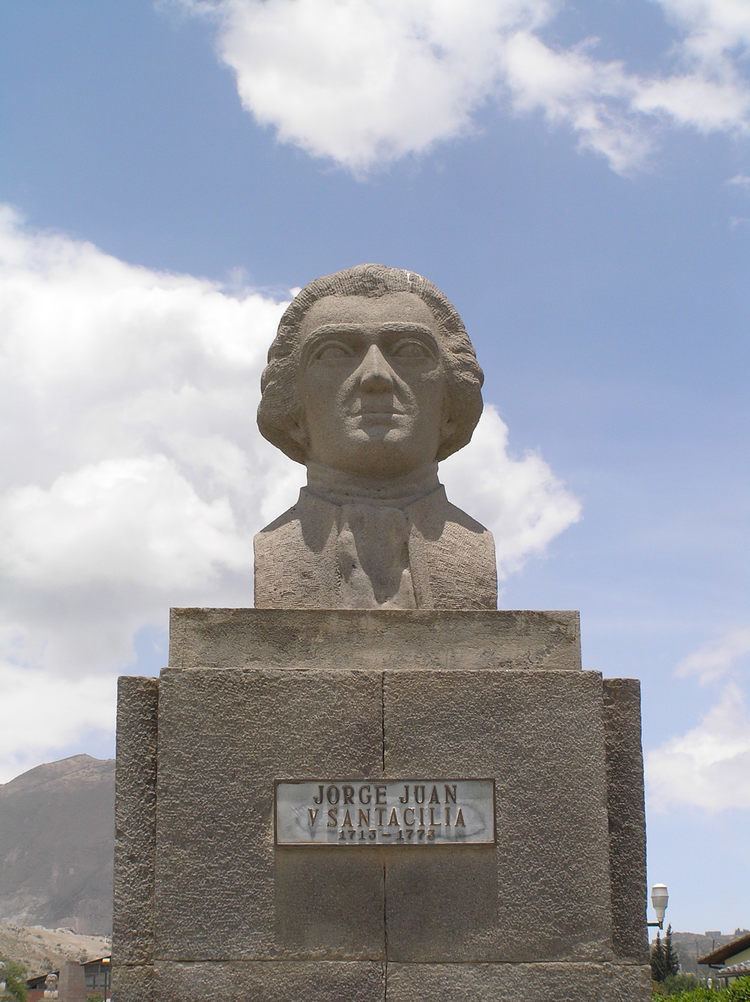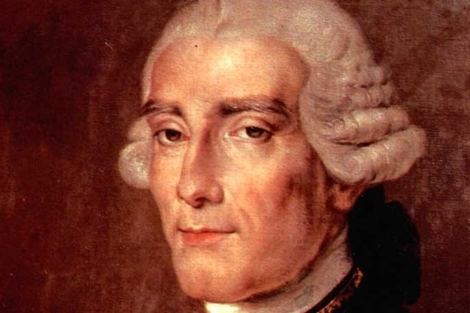Name Jorge y | Role Scientist | |
 | ||
Education Escuela Naval Militar de Oficiales (1730–1734) Books Discourse and Political Reflections on the Kingdoms of Peru, Their Government, Special Regimen of Their Inhabitants, and Abuses which Have Been Introduced Into One and Another, with Special Information on why They Grew Up and Some Means to Avoid Them Similar People Antonio de Ulloa, Charles Marie de La Conda, Louis Godin, Pierre Bouguer | ||
Monument to Jorge Juan y Santacilia
Jorge Juan y Santacilia (Novelda (Alacant), January 5, 1713 – Madrid, June 21, 1773) was a Spanish mathematician, scientist, naval officer, and mariner.
Contents
- Monument to Jorge Juan y Santacilia
- Semblanza del cientfico Jorge Juan y Santacilia
- Family and Education
- Career
- Works
- In collaboration with Antonio de Ulloa
- References

Semblanza del científico Jorge Juan y Santacilia
Family and Education

Jorge Juan was born on the estate El Fondonet, the property of his grandfather don Cipriano Juan Vergara in Monforte del Cid, Alicante, Spain. He was baptised in the Church at Monforte del Cid. Juan was born of two distinguished families: his father was don Bernardo Juan y Canicia who came from the branch of the Counts of Penalba, and his mother was dona Violante Santacilia y Soler de Cornella, who came from prominent land-owning family in Elche. Both of his parents were widowed and remarried. They lived in their house on the Plaza del Mar in Alicante and only vacationed in Novelda.

His father died when Juan was only three years old and under the care of the Jesuits of the Jesuit school in Alicante. His uncle don Antonio Juan, a Canon at the Collegiate Church took charge of young Jorge and continued his education. Later another uncle, don Cipriano Juan, a Knight of the Order of Malta, took charge of his education and sent him to Zaragoza for a preparatory education for higher studies.

At the age of 12 he was sent to Malta to receive Holy Orders at the Order of Malta. The next year he became page to the Grand Master don Antonio Manuel de Villena, who granted him the title of Commander of Aliaga in Aragon. Thus he received his first title when he was only 14. Soon he became a Knight of the Order of Malta, which implied lifelong celibacy.
In 1729, when he was 16, he returned to Spain and applied for entry to the Royal Company of Marine Guards, the Spanish military school for naval officers. He entered the academy in 1730 and studied modern technical and scientific studies subjects such as geometry, trigonometry, astronomy, navigation, hydrography, and cartography. He also completed his education in the humanities with classes in drawing, music and dancing. He earned the reputation of being an outstanding student and his fellow students called him Euclid. He finished his studies at the academy in 1734. At the young age of 22 he was given command of a corvette and he participated in the expedition against Oran and the campaign of Naples.
Career

In 1734, King Philip V of Spain asked Jorge Juan and fellow scientist Antonio de Ulloa to join the French Geodesic Mission organized by the French Academy of Sciences from Paris, under command of the astronomer Louis Godin. The mission was to measure the length of a degree of meridian arc at the Equator in South America and to determine the roundness of the Earth. On May 26, 1735 they left Cadiz in the company of the Marquess of Villagarcia, who had just been appointed Viceroy of Peru. Jorge Juan was on board the ship El Conquistador and Antonio de Ulloa on the frigate Incendio. The expedition traveled to Quito in present-day Ecuador and after nine years of careful study, determined that the Earth is not perfectly spherical but is oblate, i.e. flattened at the poles. Juan also successfully measured the heights of the mountains of the Andes using a barometer.
Juan remained nine years in America, studying the political and social situation of the Spanish territories. Amongst other things he observed a new metal the miners called Platina de Pinto (little silver of the Pinto river). On his return to Spain, King Ferdinand promoted him to captain. For their work and discoveries in Peru, both he and de Ulloa were elected Fellows of the Royal Society, Santacilia in 1749.
The Marques de la Ensenada ordered Juan to travel to England secretly to study new naval construction methods and armament of the British. In 1749 he travelled incognito under the name of Mr. Josues and learned all that he could in England (writing back in a numerical cypher), and brought back 50 British naval constructors. In an ironic twist, many of them (including Matthew Mullan and Richard Rooth) went on to build the Spanish ships that would later fight in the American Revolutionary War and the battle of Trafalgar. He was however disappointed with the English naval construction methods and upon is return to Spain in 1750 he was placed in charge of Spanish naval construction, creating his own naval construction system (approved in 1752) and improving the shipyards (such as the ones in Cartagena, Cadiz, Ferrol, Havana) and armaments. He implemented modern industrial division of labor among the different disciplines involved in naval construction such as dry-docks, shipyards, furnaces, rigging and canvas manufacturing.
In 1757 he founded the Royal Astronomical Observatory of Madrid (Real Observatorio de Madrid).
He died in Madrid in 1773 at the age of 60. His reported symptoms, including muscle stiffness and seizures, were almost certainly the result of a cerebral amebic infection. He was buried in the church of San Martin.
